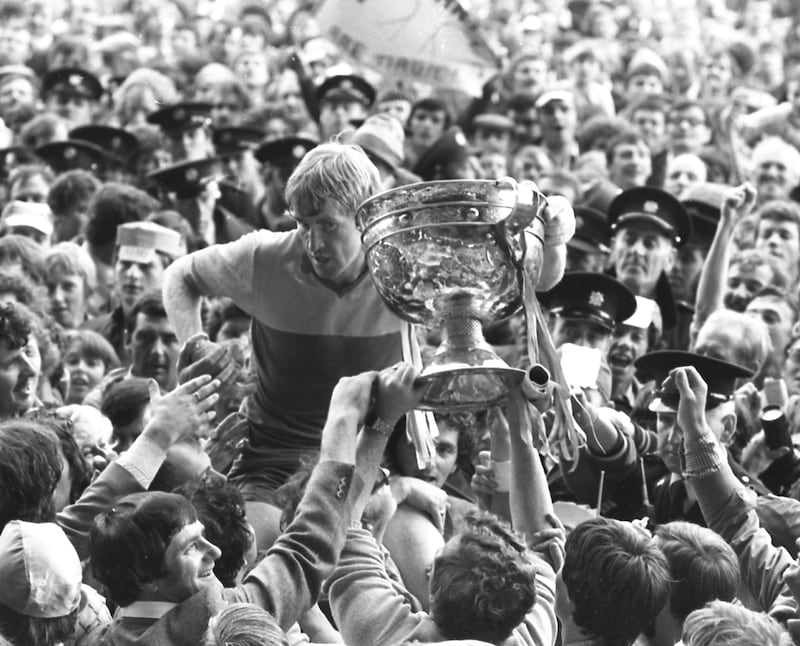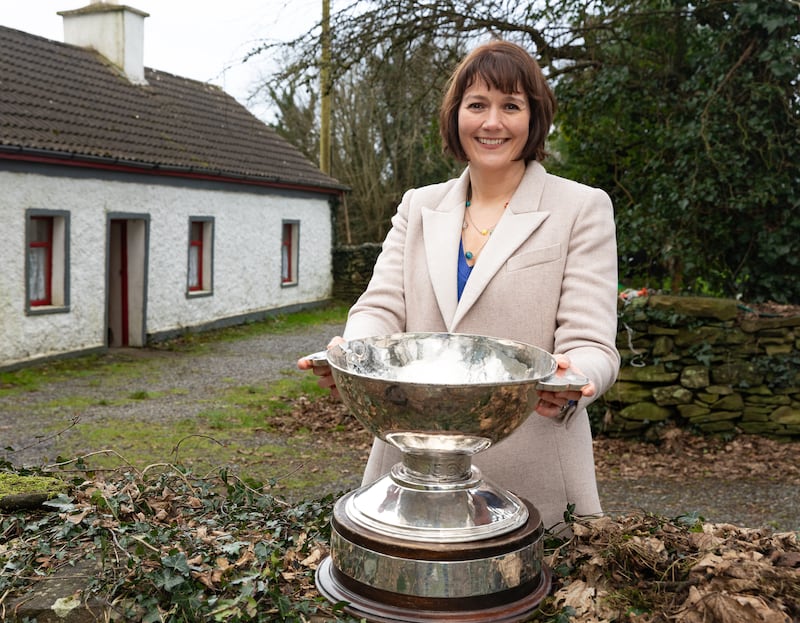Scéalta na gCorn reached the halfway mark on Wednesday evening.
TG4′s series on the trophies of the GAA has already forged connections and revived memories and for presenter Gráinne McElwain it is a bit like revealing “the history of Ireland and the story of the GAA through its cups”.
The broadcaster and Sky Sports GAA anchor became involved in the project on the suggestion of Imagine Media’s assistant producer Hannah Ní Dhubhcháin, who based the idea on GAA Family Silver, the thorough inventory of “101 cups and trophies” by Humphrey Kelleher, who is the programme’s consultant.
From the most famous of the trophies to broadly unknown local prizes, the cups do trace a story of Gaelic games and their evolution from the earliest trophy, the Silvermines Cup, presented by Michael Cusack in 1886 as the reward for a match in Dublin between North Tipperary and South Galway.
Ken Early: The future of Real Madrid is suddenly uncertain
Irish player tracker: Mark McGuinness shows grit, leadership and class for Luton Town
Leitrim’s spirited defeat to Mayo treated with glee compared to glory days of the 1990s
No magic for Carlo Ancelotti as Real Madrid fail to come back against Arsenal
Although there are a large number of cups, there are also many that have gone missing in the mists of time although one that intrigues McElwain has only disappeared this century.
“Hannah’s research turned up a stat that there are about 2,000 pieces of silverware around the country,” she says. “Some have been lost. In the Galway episode, we look at the Inky Flaherty Cup (named after the great former Galway hurler). This was given for the Connacht hurling championship from 1995 but it stopped in 1999 when the championship was abandoned because of Galway’s dominance.
“The cup is missing. No one knows where it is. I would love if this series could help to unearth it. Maybe someone, who recognises it in the Galway programme, could come forward. Somebody has it and may not even know what it is.
“The ‘Little Norah’ Cup in Cork was found under someone’s bed after an appeal in the Southern Star and I’m convinced there are other missing trophies up in people’s attics and cupboards or in antique shops around the country.”
The determination to recognise and celebrate history has been much in evidence in the past couple of weeks and arguably the most iconic of trophies, football’s Sam Maguire, has been prominent.

Only last weekend in Kildare town, GAA president Larry McCarthy unveiled a statue to Bill ‘Squires’ Gannon, who captained the county to the All-Ireland in 1928 and became the first man to be presented with the Sam Maguire.
Within a few weeks, on Cavan’s Main Street, near the Market Square, another sculpture – this time of John Joe O’Reilly, the only captain to raise the trophy overseas, at the end of the Polo Grounds final in New York 75 years ago – will be unveiled.
Scéalta na gCorn, however isn’t simply about the big, revered trophies for the games’ greatest achievements, according to McElwain.
“Often, people don’t know the name of the cups even when they’re getting them. The series gives a picture of who these people were and what role they played in the GAA in the era when they were active and what was happening socially and politically. A lot are named after political figures, like in our Cork episode we have Terence MacSwiney and Tomás Mac Curtain.
[ Donegal’s Neil McGee retires from intercounty football after 18 seasonsOpens in new window ]
“But I love the fact that we also focus on ordinary people in the GAA and how they end up with cups named after them, like the Maggie Close Cup (Antrim under-14, seven-a-side). I just think it’s lovely, as she’s someone who dedicated her life to the GAA and – we all know people like her – who did everything that was asked and beyond.
“So it’s not just chairs of committees and secretaries but ordinary volunteers. For a lot of people it’s just a cup but for the families, it’s the memory of a loved one living on and not forgotten, which is really important.”
There are also slightly revealing narratives, like the Dublin football championship trophy being named after Clerys, the department store with the famous clock, which had a strong GAA connection.
In the 1940s and ‘50s, proprietor Denis Guiney, a Kerry man who according to Wexford hurler Billy Rackard, zealously recruited intercounty players for his relentless pursuit of the Kickham Cup, which was contested by the drapery houses in the city.
Rackard acknowledged in his memoir, No Hurling at the Dairy Door: “When applying for the job at Clerys, my GAA pedigree certainly did me no harm.”
McElwain makes the point that it wasn’t unusual for businesses to sponsor trophies. For instance, the sadly departed Irish Press, which pioneered newspaper coverage of Gaelic games from its foundation in 1931, lent its name to the All-Ireland minor hurling trophy.

“It makes sense in that you see it around the country. In Galway you had the Odlums Cup, for instance. At a time when there wasn’t a lot of money around, companies had the resources to pay for trophies. The same applied to priests and emigrants, who also sponsored cups. They had the money to provide silverware.”
After the six-part series, they might project continue to cover the whole country and unearth further stories behind the balance of the 2,000 trophies.
“Well, what we’re hoping is that it will be a recurring series – or at least have the makings of a couple more series,” she says.
Scéalta na gCorn continues on TG4 next Wednesday evening at 8.30, featuring Donegal, and for the following two weeks with the focus on Galway and then Cork. The first three episodes of the series dealt with Dublin, Monaghan and Antrim and are available on the TG4 Player















